
35. Piriformis, obturator internus and externus, the gamelli and quadratus femoris
Anatomy
Piriformis, Obturator internus and externus, the Gamelli and Quadratus femoris are deep and not easily palpable. Generally they arise on pubic and ischial rami and attach on the posterior aspect of inter-trochanteric crest, except piriformis which arises on the anterior sacrum passes through the greater sciatic foramen and attaches on the superior greater trochanter. The piriformis muscle may be partly or completely absent or exhibit anatomical variations. Action: Lateral rotation of the thigh. They also help to stabilise the hip joint.
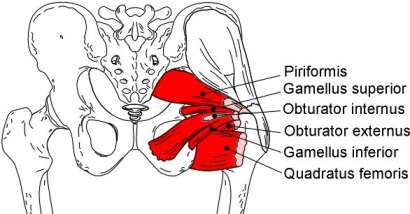
Sciatic nerve - derived from lumbarsacral plexus L4, 5, S1, 2 & 3. The sciatic nerve may pierce the piriformis or pass under it. If hypertonic the piriformis may result in sciatica.
A hypertonic piriformis also has the ability to displace the sacrum anteriorly and laterally, and thus distort the sacroiliac joint and stretch the ligaments over the joint. The piriformis should be checked in all back pain syndromes because displacement of the sacrum creates the possibility of nerve impingement of the sacral plexus.
A hypertonic obturator externus can irritate the obturator nerve as it passes through the obturator foramen and the obturator externus muscle. There may be symptoms of pain, burning and tingling in the anterior and medial thigh and groin.
Technique 1 Kneading and inhibition for the hip lateral rotators and gluteal muscles.
Patient
- Prone with the head straight in a face hole or rotated towards the side you are standing.
Therapist
- Stand by the side of the table level with the patient's hips.
- Grasp the patient's ankle that is furthest from you with your caudad hand and flex their knee to 90 degrees.
- Reach over the patient's pelvis with your cephalad hand and make contact on the muscle to be treated with your applicator.
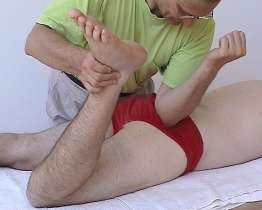 Picture 35.1
Picture 35.1Applicator
- Olecranon process.
- Alternatives: knuckles of clenched fist, the tip of the thumb or pisiform bone.
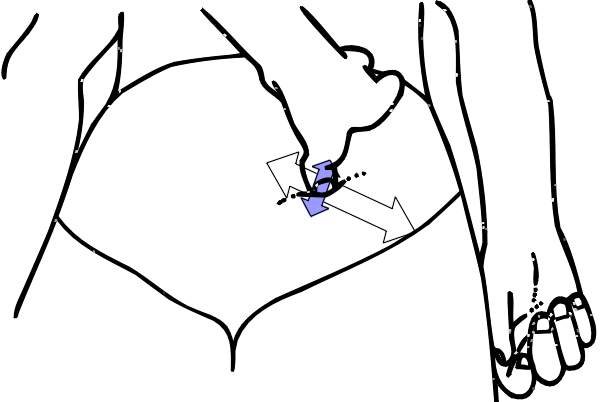 Figure 35.1
Figure 35.1| Muscle Fibres | Primary Force | Secondary Force | Stretch Force | Contraction Force |
Tissue tension
- Take up the primary tissue tension with compression and a transverse pressure by applying a cross fibre force on the muscles with your applicator.
- Take up the longitudinal tension by pushing the patient's leg away from you thereby increasing medial rotation at the hip.
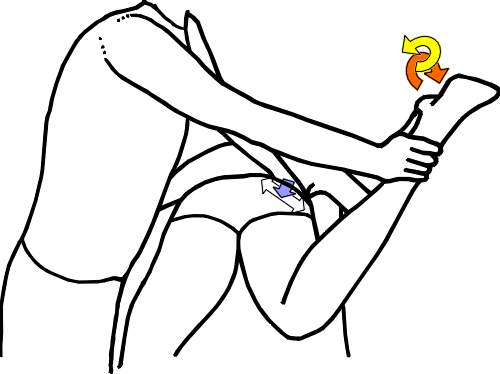 Figure 35.2
Figure 35.2| Muscle Fibres | Primary Force | Secondary Force | Stretch Force | Contraction Force |
Kneading
- Rotate the ankle in a circular motion thereby moving the hip through a cycle of internal and external rotation.
- Apply a rhythmical cycle of compression and transverse force.
- When the muscle is at an optimal point in the rotation cycle increase the primary forces.
- The optimum point of tension depends on which of the muscle you are treating.
- For gluteus minimus the optimum point to emphasis the pressure of your contact is in external rotation. For piriformis and the other lateral rotators it is in internal rotation.
- Your pressure should be just short of discomfort.
- To relax the muscle work with the patient's breathing cycle of 15 breaths per minute.
- To stimulate the muscle increase your speed to about 40 cycles per minute.
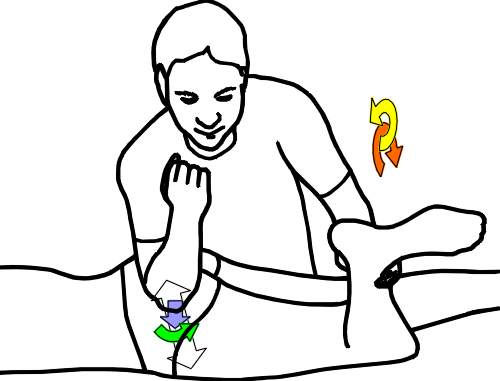 Figure 35.3
Figure 35.3| Muscle Fibres | Primary Force | Secondary Force | Stretch Force | Contraction Force |
Active component
- Ask the patient to take a deep breath and hold it in.
- Ask the patient to attempt to contract their muscle for 3 to 5 seconds using a 10% effort.
- For gluteus maximus ask them to lift their thigh off the table.
- For gluteus medius and tensor fascia lata ask them to push their thigh to the side.
- For gluteus minimus ask them to rotate their hip inwards.
- For the lateral rotator muscles ask them to rotate their hip outwards.
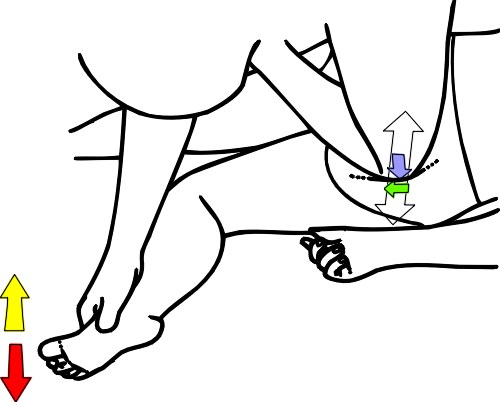 Figure 35.4
Figure 35.4| Muscle Fibres | Primary Force | Secondary Force | Stretch Force | Contraction Force |
- Resist their effort and maintain tissue lockup throughout inhalation.
- Ask the patient to exhale and to relax their muscle contraction.
- As soon as you feel that the patient has relaxed their gluteus maximus completely (about 3 seconds) take up the tissue slack by increasing the primary and secondary tension.
- Take up the slack after each contraction and during exhalation.
- Repeat 2 or 3 times or as required.